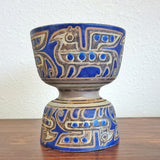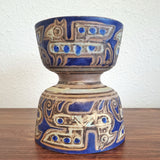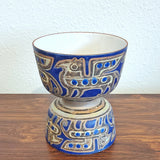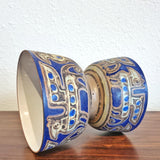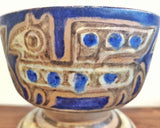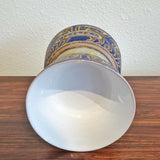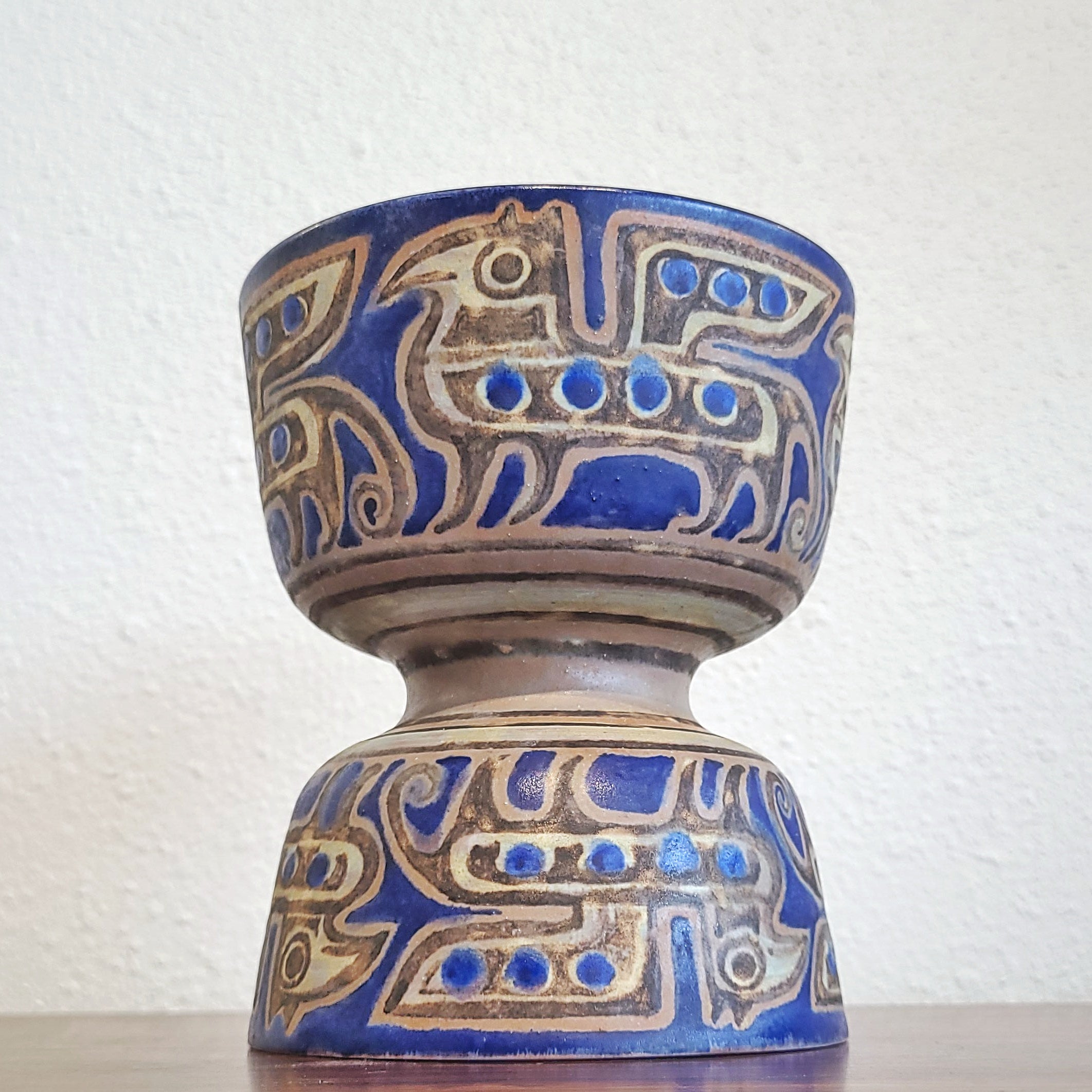
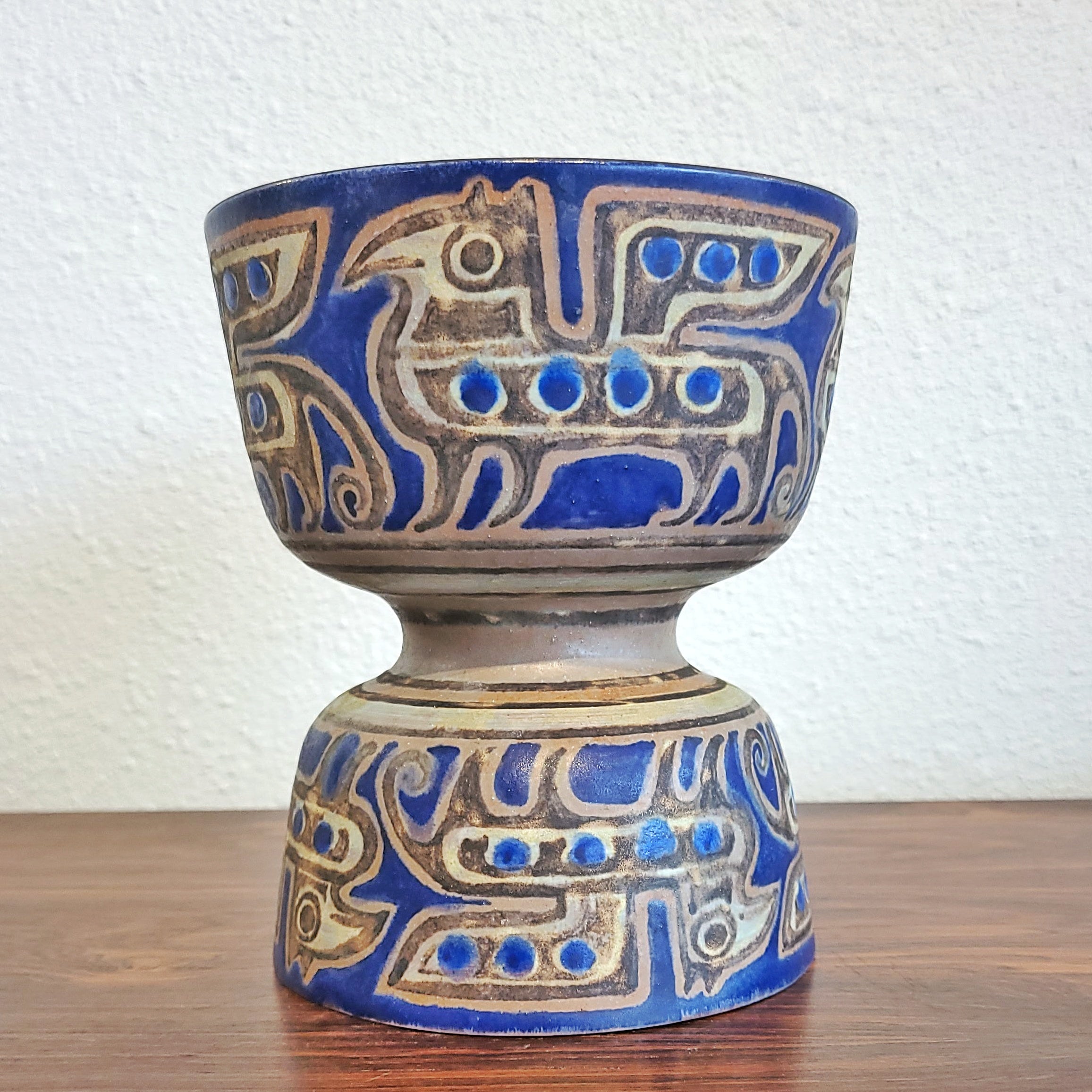
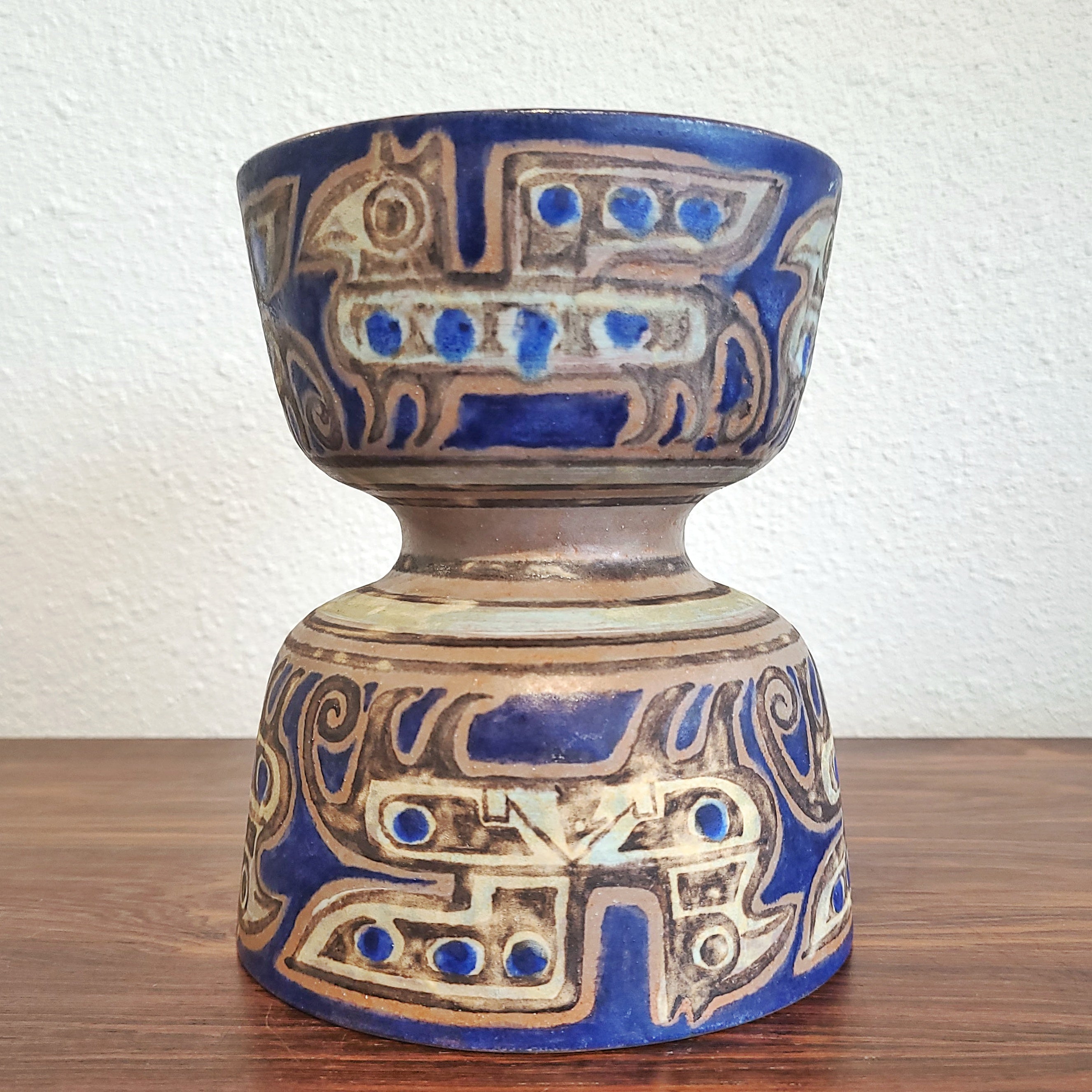
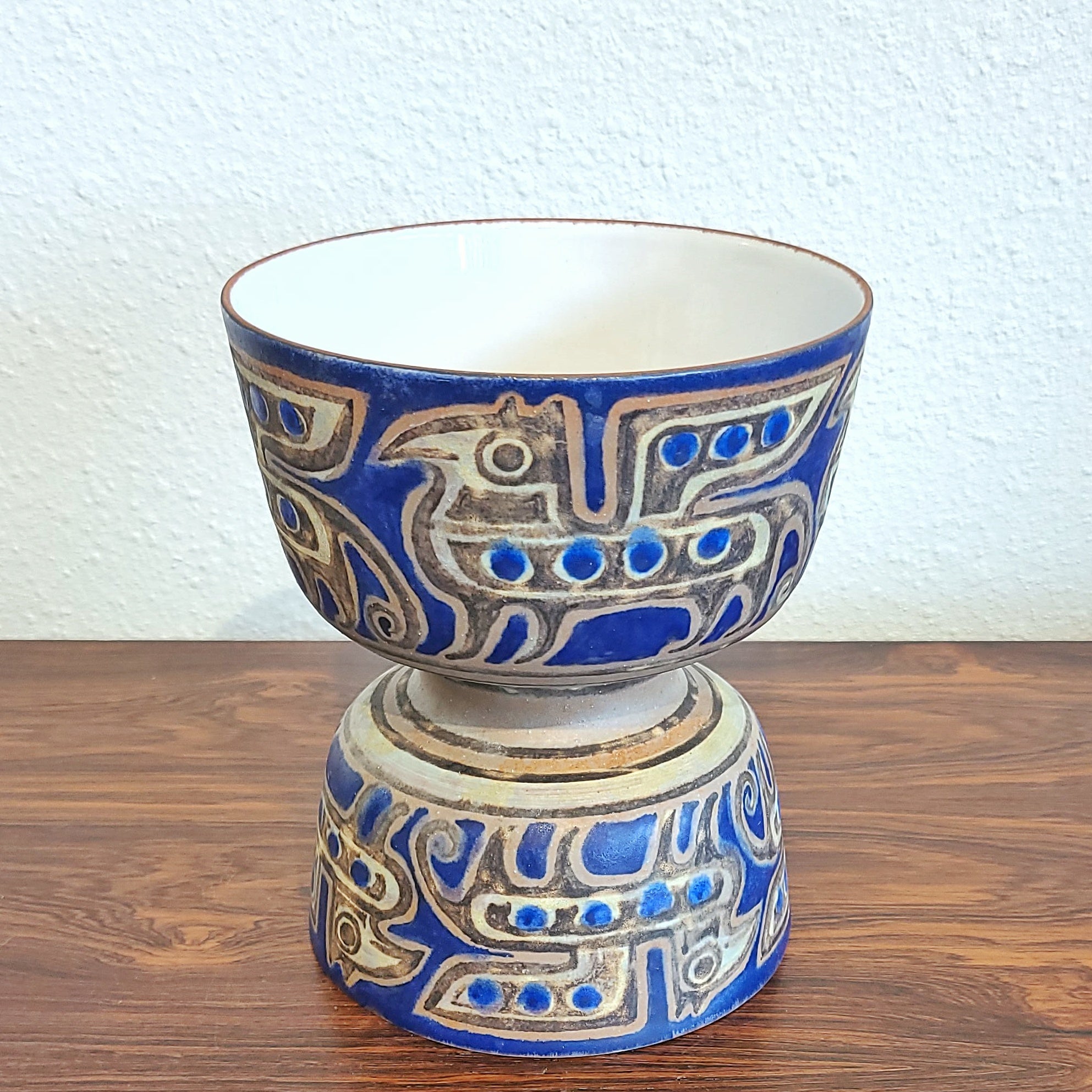


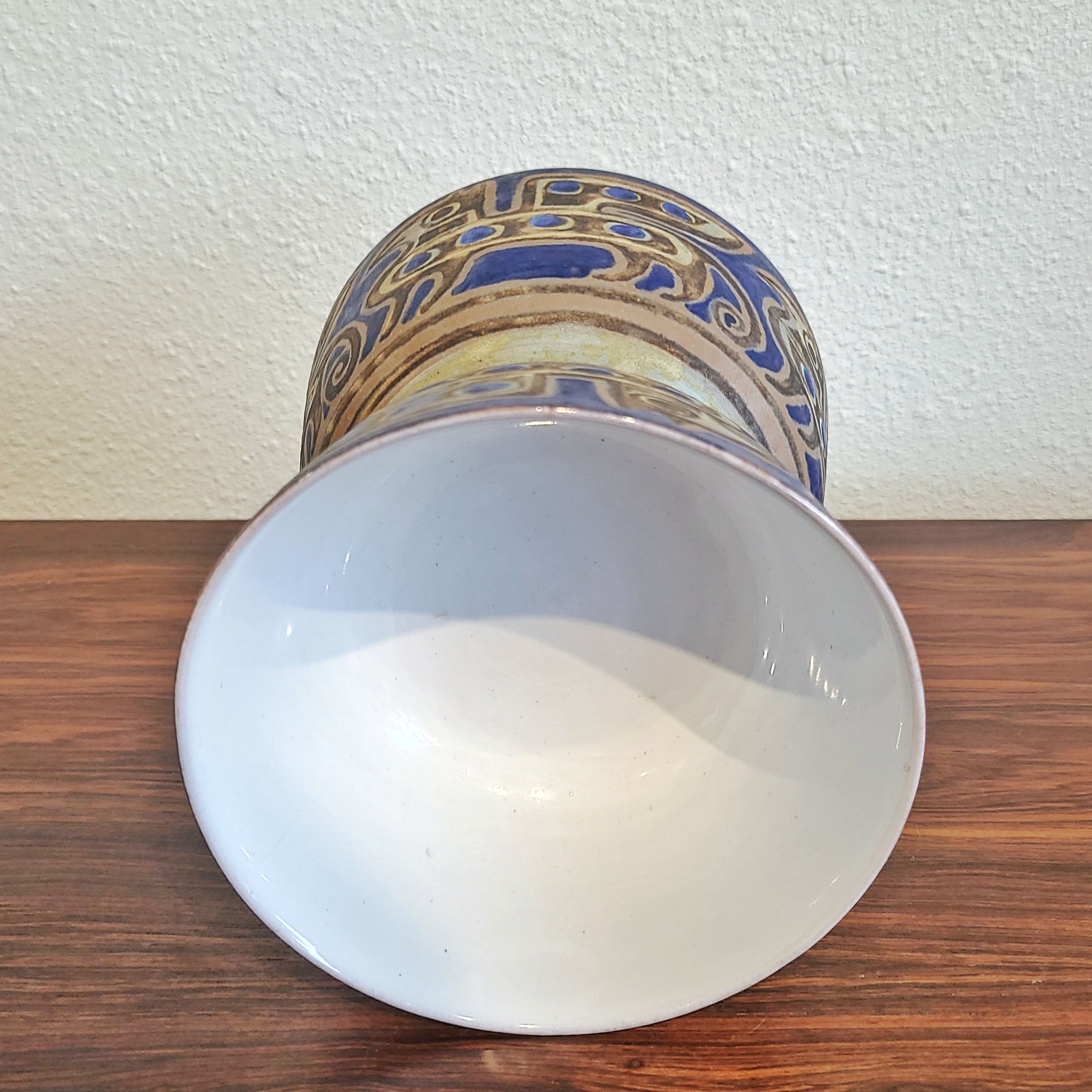
EVA FRITZ-LINDNER STUDIO POTTERY COMPOTE
CONTACT US HERE ABOUT THIS ITEM.
A beautiful hand thrown and hand painted compote, cachepot, or vase created by well-known sculptor and potter Eva Fritz- Linder. It is in the form of two bowls, one larger, one smaller, attached at their bases to form a single receptacle it can be inverted if desired. The unique 'griffin' decor wraps around both bowls. Though unmarked, it is undoubtedly the work of Fritz-Linder.
EVA FRITZ-LINDNER was a celebrated folk-art sculptor and ceramicist whose work is avidly pursued today by worldwide collectors. Born in Düsseldorf in 1933, she served as an apprentice at the Werkkunstschule—the applied arts training center—in Wiesbaden in Hesse for five years, from 1949 through 1954, and was a master student in Erich Kuhn's sculpture class for the final two. At the age of 22 she was awarded the Grand Prix at a 1955 exhibition in Cannes: Five Millennia of German Ceramics. Soon after Fritz-Lindner was hired as a master designer by the State Majolica Manufactory in Karlsruhe where she was employed for nearly a decade, through 1963, becoming one of its most popular artists. Major accolades earned during this tenure were a 1958 Baden-Württemberg Arts Prize and the Silver Medal at the International Ceramics Exhibition in Prague in 1962.
Stepping out of a limelight she had never fully embraced, Fritz-Lindner withdrew to her private studio in Karlsruhe-Durlach in 1964 and started to freelance exclusively. She designed and created hundreds of highly-regarded ceramic folk-art sculptures rendered with creativity and whimsy. Animals (owls, in particular) and family were frequent themes. Her success led to commissions for larger works for public and private gardens and buildings; examples include mosaic wall designs in Mannheim, Schwäbisch Gmünd, and Göppingen. Of particular note, she created four enormous outdoor owl sculptures for the Palace Gardens in Karlsruhe in 1967. Whatever the size of the work, Fritz-Lindner hand-painted each one of her creations in distinct and colorful fashion. She would on occasion supply designs for glass works to be produced in Murano, Italy. Fritz-Lindner died in 2017.
Fritz-Lindner's ceramics reside in the Hetjens-Museum Düsseldorf, the Museum of Contemporary Ceramic Art in Frechen, the Württemberg State Museum Stuttgart, in Badenisches Landesmuseum Karlsruhe, the Museum of Applied Art in Cologne, and the Museo National de Cerámica Valencia—as well as in public gardens and buildings and in private collections.
MAJOLIKA KARLSRUHE (more formally, Staatliche Majolika Manufaktur Karlsruhe) was organized at Karlsruhe in southwest Germany in 1901 when Grand Duke Friedrich I agreed to build a ceramics factory at the behest of German pictorial artists Wilhelm Süs and Hans Thoma. Their goal was to revive the so-called "majolica" or faience technique, where opaque, tin-based glazes were applied to earthenware to serve as the basis for colored decoration. (The tin glaze used in majolica is actually a lead glaze that has been rendered white and opaque by the addition of tin oxide. In the production process, unglazed articles are first fired in a kiln and then dipped in the tin glaze, which is allowed to dry. Designs are then painted on the glaze, which sets them off and preserves them during a second, high-temperature firing.) Towards the end of the decade, a signature style of majolica had developed: compositions, often including cherubim, on a blue background.
The pottery passed through various hands in the following years, at one time being occupied by Villeroy & Boch, with the premises being owned by the state of Baden. (In 1927 the word 'Staatliche' was added to the name to indicate state ownership.) Despite the specificity of its name, MAJOLIKA KARLSRUHE produced a wide range of artisan ceramics and was one of Germany's leading producers of ceramics generally. The quality of production was excellent. Top designers prior to WWII included Ludwig König and Max Läuger.
The factory was badly damaged by bombs in 1944 and did not return to the full-time production of decorative goods until the 1950s, when business resumed much as in pre-war days, with both company-employed and freelance designers. One of the foremost post-war designers was Friedegart Glatzle, who joined MAJOLIKA KARLSRUHE in 1951, and who over the next 30 years produced a huge range of designs. Other designers of note during this period included luminaries Eva Fritz-Lindner and Werner Meschede. To this day the company provides artists with their own studio space and commissions work from them. Product examples can be seen at the Badisches Landesmuseum in Karlsruhe.
Most MAJOLIKA KARLSRUHE pieces bear the company's name and symbol—the arms of Baden above a double-joined 'M' for Majolika-Manufaktur. Items are made with red-orange clay and are marked with a form number.
Details
- Dimensions
- 6ʺW × 6ʺD × 4.25ʺH
- Styles
- Boho Chic
- Figurative
- Mid-Century Modern
- Period
- 1950s
- Place of Origin
- Germany
- Item Type
- Vintage, Antique or Pre-owned
- Materials
- Ceramic
- Condition
- Very Good Condition, Original Condition Unaltered, No Imperfections
- Color
- Blue
- Condition Notes
- Excellent Vintage Condition


